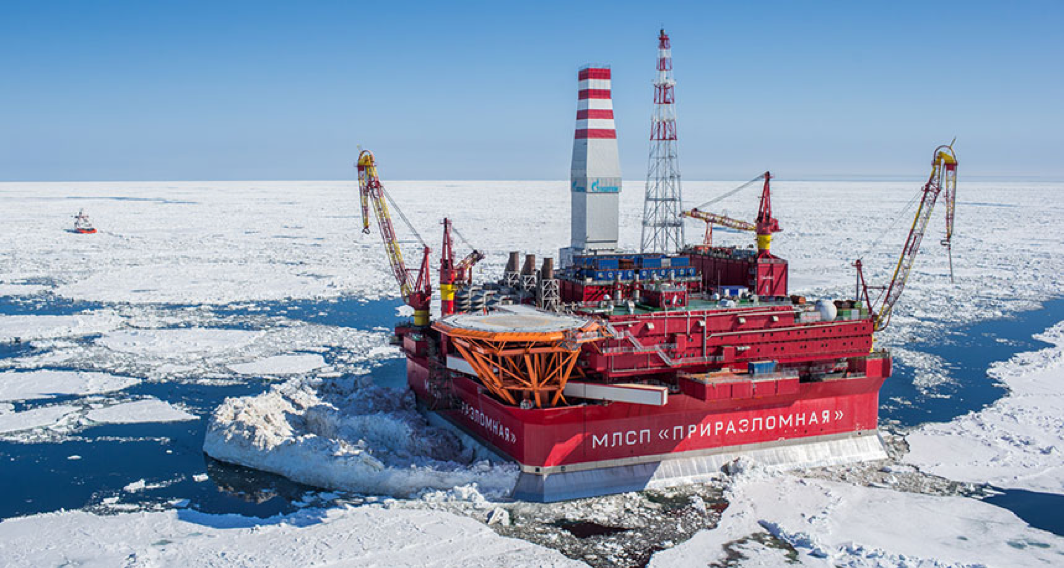
By Samantha E. Teets, staff editor
Regardless of what you believe causes climate change, we can all agree – it’s getting hot out here. The Earth’s temperature increased from 1.1 to 1.6-degree Fahrenheit between 1906 and 2005.[2] That statistic alone may not mean much to you, but couple it with the fact that the rate of temperature increase has nearly doubled in the past 50 years, and it’s clear that climate is changing quickly (though not as quick as John Kerry thought in 2009, when he predicted that we would have an ice-free Artic come 2013).[3] Still, the artic sea ice is melting – and at a rate of 12.85 percent per decade.[4] The diminishing artic presents compelling economic and strategic opportunities for the United States and Russia , who have taken notice.
Under International law, no one owns the Artic region around the North Pole.[5] However, nations with territory in the Artic (such as the United States, Russia, Norway, Canada and Denmark) own and hold absolute rights to the water that extends 12 nautical miles from their shores.[6] Even more significant, states enjoy absolute economic rights to fishing, oil and gas up to 200 nautical miles from their shores[7] and there could be as much as $35 trillion dollars’ worth of untapped resources in the Artic region. Russia (whose coastline accounts for 53% of all coastline on the Arctic Ocean) is particularly eager to cash in.[8] In fact, Russia has already started costly operations to extract resources from the region.[9] Extreme water depth, and harsh climate conditions only provide around three to four months of ice free conditions for oil extraction, thus making the process lengthy and expensive. [10] As climate change continues to warm the Earth and melt the Artic region, oil and mineral extraction operations will be more feasible, and more states are likely to expand their operations in the region.
Beyond the enticing economic prospects, the Artic also holds strategic significance to the states that surround it. Traditionally, the Artic Policy of the United States has been centered around the view that the region presents an opportunity to enhance the capability of U.S forces to defend the homeland by preserving freedom of the seas and mobility through the region.[11] Recently, the United States expanded this policy to acknowledge competing interests with Russia and China in the region.[12] The United States is concerned that China will continue similar practices to that in the South China Sea.[13] In the past few years, China constructed man made islands in the South China Sea to secure territorial and economic rights to the waters that surround these islands. [14] The U.S. is also concerned with an increased Russian military presence in the Artic region. In 2014, in addition to their efforts to establish air defense and coastal missile systems, Russia added new Artic units, refurbished old airfields and infrastructure and established new military bases along their Artic coastline. [15] It’s evident to each of these states that they may have to compete to reap the of the economic and strategic military benefits the Artic presents.
The Artic represents a land of unknown and seemingly endless possibilities. If warmer climate trends continue, I believe additional challenges to U.S security could emerge. The potential economic race for resources in the Artic region has the capability to incite undesired consequences of unknown scope and gravity. Therefore, it is crucial that the United States gather a comprehensive view on the impacts of climate change, to more accurately evaluate the risks of national security in the Artic region.
[1] Thomas Sumner, Ice rafts traveling farther and faster across the Arctic Ocean, (Dec 17, 2010) https://www.sciencenews.org/article/ice-rafts-traveling-farther-and-faster-across-arctic-ocean.
[2]Global Warming, Nasa Earth Observatory (Jun 3,2010) https://earthobservatory.nasa.gov/features/GlobalWarming/page2.php.
[3]Global Warming, Nasa Earth Observatory (Jun 3,2010) https://earthobservatory.nasa.gov/features/GlobalWarming/page2.php; Ben Marquis, Video: In 2009 Kerry Said Arctic Could Be Ice-Free in 4 Years. A Decade Later & It’s Still Frozen, (Apr. 12, 2019) https://www.westernjournal.com/video-2009-kerry-said-arctic-ice-free-4-years-decade-later-still-frozen/.
[4] Vital Signs of the Planet, https://blog.nationalgeographic.org/2011/05/19/who-owns-the-north-pole/ (last visited Jan 22,2020).
[5] Vital Signs of the Planet, https://blog.nationalgeographic.org/2011/05/19/who-owns-the-north-pole/ (last visited Jan 22,2020).
[6]Enric Sala, Who Owns the North Pole https://blog.nationalgeographic.org/2011/05/19/who-owns-the-north-pole/ (last visited Jan 22,2020).
[7]Clay Dillow, Russia and China vie to beat the US in the trillion-dollar race to control the Arctic, (Feb. 6, 2018) https://www.cnbc.com/2018/02/06/russia-and-china-battle-us-in-race-to-control-arctic.html.
[8]Holly Ellyat, Russia is dominating the Arctic, but it’s not looking to fight over it (Dec. 27, 2019) https://www.cnbc.com/2019/12/27/russias-dominance-in-the-arctic.html.
[9] Holly Ellyat, Russia is dominating the Arctic, but it’s not looking to fight over it (Dec. 27, 2019) https://www.cnbc.com/2019/12/27/russias-dominance-in-the-arctic.html.
[10] The Oxford Institute for Energy Studies, The Prospects and Challenges for Arctic Oil Development (2014), available at https://www.oxfordenergy.org/wpcms/wp-content/uploads/2014/11/WPM-56.pdf
[11] Erica Martison, The Military Thinks Bolstering its Presence in the Arctic is Necessary, but That May Not be Enough to Make it Happen, (Dec. 2, 2017) https://www.adn.com/alaska-news/military/2017/01/27/the-military-thinks-bolstering-its-presence-in-the-arctic-is-necessary-but-that-may-not-be-enough-to-make-it-happen/.
[12] Malte Humper, New U.S. Department of Defense Arctic Strategy Sees Growing Uncertainty and Tension in Region,(Jun 7, 2019) https://www.highnorthnews.com/en/new-us-department-defense-arctic-strategy-sees-growing-uncertainty-and-tension-region.
[13]Erica Martison, The Military Thinks Bolstering its Presence in the Arctic is Necessary, but That May Not be Enough to Make it Happen, (Dec. 2, 2017) https://www.adn.com/alaska-news/military/2017/01/27/the-military-thinks-bolstering-its-presence-in-the-arctic-is-necessary-but-that-may-not-be-enough-to-make-it-happen/.
[14] Malte Humper, New U.S. Department of Defense Arctic Strategy Sees Growing Uncertainty and Tension in Region,(Jun 7, 2019) https://www.highnorthnews.com/en/new-us-department-defense-arctic-strategy-sees-growing-uncertainty-and-tension-region.
[15] Malte Humper, New U.S. Department of Defense Arctic Strategy Sees Growing Uncertainty and Tension in Region,(Jun 7, 2019) https://www.highnorthnews.com/en/new-us-department-defense-arctic-strategy-sees-growing-uncertainty-and-tension-region.